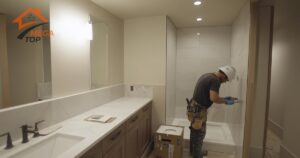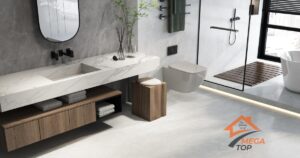Can You Replace a Tub with a Shower?
Replacing a bathtub with a shower is a common bathroom renovation project, offering modern aesthetics, improved functionality, and enhanced accessibility. Whether you’re seeking a sleek walk-in shower or a compact option for a small space, this conversion can elevate your bathroom’s appeal.
Reasons to Replace a Tub with a Shower
- Accessibility: Showers are safer and easier to use, especially for seniors or individuals with mobility challenges.
- Space Efficiency: A shower can open up your bathroom, making it appear larger and more functional.
- Modern Design: Showers provide a contemporary look that complements today’s bathroom trends.
Is It a Simple Process? Factors to Consider
While replacing a tub with a shower is feasible, the ease of the process depends on factors like plumbing, space, and design preferences. Professional guidance ensures a smooth conversion.
Key Steps in Replacing a Tub with a Shower
1. Planning and Measuring Your Space
Start by evaluating your bathroom’s layout to determine the best shower style and size. Accurate measurements are crucial to avoid complications during installation.
2. Removing the Existing Bathtub
- Turn off the water supply and disconnect plumbing.
- Remove the tub, surrounding tiles, and fixtures carefully to avoid damaging walls or floors.
3. Preparing the Bathroom for a Shower
- Inspect the subfloor and walls for damage or mold.
- Ensure the plumbing aligns with the new shower configuration.
4. Installing the Shower Base and Walls
- Choose a pre-fabricated shower base or custom tile floor.
- Securely install wall panels or tiles, ensuring proper waterproofing to prevent leaks.
5. Adding Fixtures and Enclosures
- Install showerheads, faucets, and accessories.
- Add enclosures such as glass doors or curtains to complete the setup.
Popular Types of Shower Replacements
Walk-In Showers: Modern and Accessible
Walk-in showers are sleek and easy to access, making them ideal for both small and large bathrooms.
Shower-Tub Combos: A Space-Saving Option
If you need the functionality of both a tub and a shower, a combination unit can offer the best of both worlds.
Custom Shower Enclosures for Unique Spaces
For bathrooms with irregular layouts, custom enclosures can provide a tailored solution.
DIY vs. Professional Tub-to-Shower Conversions
Challenges of DIY Replacements
- Plumbing adjustments may require advanced skills.
- Waterproofing mistakes can lead to costly repairs.
- Specialized tools are needed for accurate cuts and installations.
Benefits of Hiring a Professional
- Guarantees proper plumbing and structural modifications.
- Ensures high-quality finishes and long-term durability.
- Saves time and reduces stress compared to DIY efforts.
Benefits of Replacing a Tub with a Shower
Enhanced Accessibility and Safety
Walk-in showers minimize slipping risks and can include grab bars for added safety.
Modernized Bathroom Design
Showers offer clean lines and contemporary features that appeal to modern homeowners.
Improved Use of Space
Replacing a bulky tub with a shower frees up floor space, making your bathroom feel more open.
Costs of Replacing a Tub with a Shower
Factors Affecting the Cost
- Material Choice: Tile, glass, and acrylic options impact the price.
- Plumbing Changes: Adjustments to pipes and drains may increase costs.
- Labor: Professional installation adds to the expense but ensures quality.
Average Price Ranges for Tub-to-Shower Conversions
- Budget: $1,200–$3,000 for basic setups.
- Mid-Range: $3,000–$7,000 for custom designs.
- High-End: $7,000–$10,000+ for luxury installations.
Design Ideas for Tub-to-Shower Conversions
Trending Materials and Finishes
- Large-format tiles for a seamless look.
- Matte black or brushed gold fixtures for modern elegance.
Choosing the Right Shower Enclosure
- Frameless glass doors for a clean aesthetic.
- Frosted glass or patterned designs for privacy.
Common Challenges and How to Overcome Them
Plumbing Adjustments and Repairs
Reconfiguring pipes for a shower can be complex. Professionals ensure proper alignment to prevent leaks.
Waterproofing Issues
Improper waterproofing can lead to mold and water damage. Use quality materials and sealants.
Dealing with Old Construction Materials
Older homes may require additional work to update plumbing or reinforce walls.
Maintenance Tips for Your New Shower
Cleaning and Care for Shower Materials
- Use non-abrasive cleaners to maintain tiles and glass.
- Regularly wipe down walls to prevent soap scum buildup.
Preventing Mold and Mildew
- Ensure proper ventilation in the bathroom.
- Use a squeegee to remove excess water after each use.
Ready to upgrade your bathroom with a sleek shower? Contact a professional today for a hassle-free tub-to-shower conversion!
FAQ
A professional conversion typically takes 2–3 days, depending on the scope of work.
Costs vary, but most projects range between $1,200 and $10,000 depending on materials and labor.
Yes, permits may be required for plumbing or structural changes. Check with local authorities.
Absolutely! Walk-in showers are great for maximizing space in compact bathrooms.
If it’s the only tub in the house, it might reduce appeal for families with small children. However, stylish shower conversions often increase overall value.





